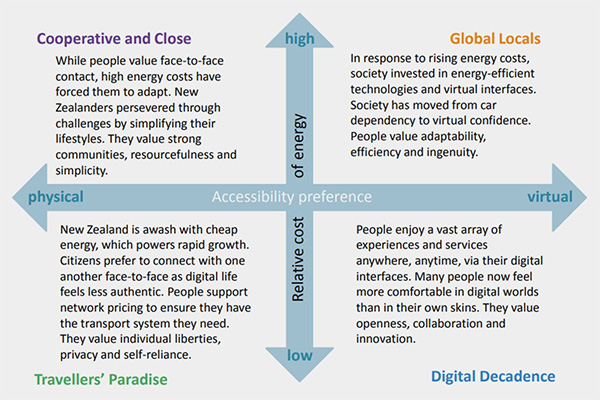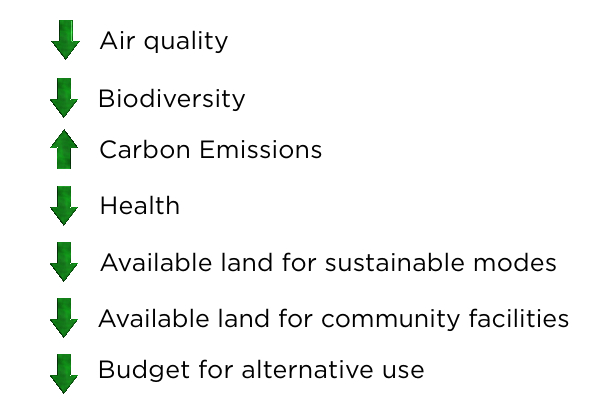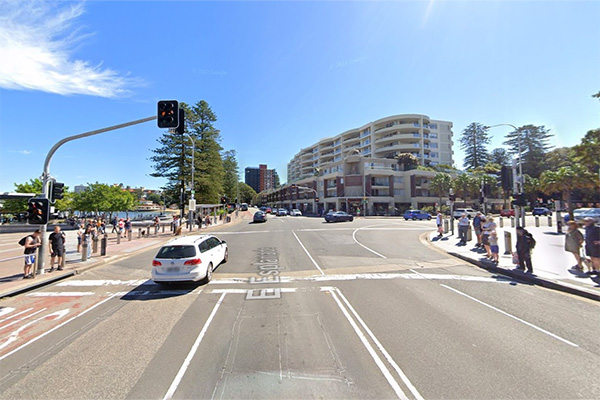A transport model is a tool for assessing the likely impacts on travel demand caused by changes in the transport network, demographics or land use.
Modelling uses mathematical relationships to represent the numerous complex decisions people make about travel to predict the future. But the models are extremely opaque and often criticised – particularly when used to justify political decisions to embark on infrastructure and development projects.
Bicycle NSW friend Ed Forrester is a transport planner and chartered environmentalist with a passion for using modelling to lead us in the right direction – towards a regenerative Net Zero future.
Ed recently attended an excellent event hosted by City of Sydney to discuss how traffic modelling impacts strategic planning and development. In this article, he shares some fascinating insights from the session.
Traditional ‘predict and provide’ transport planning supports projects to expand road capacity such as the Western Distributor ‘improvements'. But is it possible to predict future traffic growth when major public transport projects are also underway and work from home continues to change travel patterns? Will the Rozelle Interchange really cause gridlock on the Western Distributor? After all, it was conceived to divert vehicles away from the CBD. Should we still prioritise Level of Service for vehicles when we need to drive down emissions? (Image: Wikipedia)
3 speakers, 3 different viewpoints
The debate about the value of strategic modelling in transport planning has raged for a long time in many parts of the world. You might have heard the famous quote “All models are wrong, but some are useful”, often attributed to the British statistician George E. P. Box. Professor Glenn Lyons held a debate a couple of years ago as part of his excellent Fireside Chat series entitled ‘All models are wrong…. especially after a pandemic”.
City of Sydney wanted to kick start conversations about the impact of modelling on leading to road widening, induced car traffic demand and ultimately liveability at a time of serious environmental decline. Three transport professionals presented their views:
- Daniel Veryard, a strategic modeller working for Veitch Lister Consulting.
- Professor David Levinson, Professor of Transport at the University of Sydney
- Sarah Brickhill, Senior Transport Planner at the City of Sydney
The audience was mostly transport planning professionals. Like the speakers, they tend to sit in one of three camps. Some were strategic modellers, some use models to inform decisions and some speak up to change how they are used - or perhaps against their use altogether.
I will attempt to summarise each presentation as well as some of my own thoughts on the topic framed around the climate crisis that we are currently in. Please note the emphasis on the word ‘crisis’.
Strategic modelling at the coal face
Transport models are a core tool for the team at Veitch Lister Consulting, used every day to assess projects proposed by government agencies and private developers. Daniel Veryard naturally spoke up for the role of modelling in shaping cities.
However, he was keen to highlight that models don’t always lead to roads, as is the common view. He went on to showcase some of the projects which used a standard 4-step modelling process to forecast an increase in trips but distributed some of those trips onto other modes. It was good to understand how existing models can be used in a more vision-led way.
Is there a better method?
David Levinson, I think it is fair to say, is a critic of strategic modelling and its use in transport planning. He recently wrote an article entitled ‘Fantasy Modelling’
He showed a number of examples of the use of modelling in the ‘predict and provide’ paradigm. This is the traditional approach - models use historical data to try and predict the future and then decisions are made on that basis.
The Figure below shows the forecasted traffic growth from the NSW Future Transport Strategy, from TfNSW. It shows that, based on historical data and some assumptions on population and land use, traffic growth is going to dramatically increase:
Historical and forecasted future traffic (VKT) levels in Greater Sydney. Decisions on how to accommodate this ‘predicted’ growth in traffic may be used to justify new roads and road expansions – and ignore better, cheaper and more sustainable ways to improve access for everyone. And the ‘predicted’ traffic growth may not happen anyway! (Source: Transport for NSW)
Then refer to the bar graph below showing the NSW emissions targets for transport. You can see that the below graph and the figure above don’t add up. On the one hand, the Future Transport Strategy is forecasting a huge increase in Vehicle Kilometres Travelled (VKT). Yet on the other hand, Transport for NSW is committed to a net zero target for Transport Operations by 2030, 2035 and 2050. NSW apparently plans to drive down transport emissions from 26 Metric tons of?carbon dioxide equivalent?or mtCO2-e (and rising) in 2020, to 7 mtCO2-e by 2050, with interim targets along the way.
Target emissions for transport in NSW to 2050 (Source: Ed Forrester)
Something doesn’t add up. David is right to question this.
A sticky conundrum that highlights the central problem in the transport industry. Forecasting. Trying to predict the future is a fool’s errand. The future is uncertain. It always has been. We can’t predict it, and we have never been able to. Just look at the pandemic. Which transport model captured that and the acceleration towards digital access and working from home? Or the war in Ukraine driving up fuel prices? And what about the potential for the climate crisis to drive mass migration?
I was pleased to see David ackonwledge uncertianty and conclude his presentation with the need to move away from ‘predict and provide’ - using forecasts to try and predict future traffic growth and provide infrastructure to accommodate it. Inevitably leading to more roads, more traffic, more emission and poorer cities.
Planning for the future we actually want
David is an advocate for ‘decide and provide’ planning, something I wholeheartedly agree with and have been pushing for in my professional career. Transport for NSW is trying to evolve with a ‘vision and validate’ approach. As David notes, it is nice to see an attempt to envision a better future, but it does not adequately consider uncertainty, inherent in futures thinking.
‘Decide and provide’ is the approach of deciding what the future should look like and then opening out the uncertainties about the future.
I want to share this excellent diagram from some provocative work by thought-leader Professor Glenn Lyons for the New Zealand Ministry of Transport. The Ministry posed the question: ‘How could or should our transport system evolve in order to support mobility in the future?’
Professor Glenn Lyons et al used scenario planning to explore uncertainty and divergent futures (Source: NZ Ministry of Transport)
The resulting Future Demand report suggests four plausible futures. These are the alternative ways that the future might unfold in New Zealand in 2042 by considering uncertainty.
Note the difference to the NSW Future Transport Strategy, which shows one single future. The other important difference is that in some of the scenarios traffic might actually decrease! In ‘predict and provide’ models with a single forecast, road traffic forecasts are always shown to increase. We can see this playing out right now with the Western Distributor, where a forecast has been made for a single future which shows that road traffic will increase. This has led to an expensive and destructive proposal which includes adding new lanes, widening ramps, and removing pedestrian crossings.
Challenging a business-as-usual approach
This brings me to the presentation from Sarah Brickhill. Sarah discussed the mature and thoughtful strategy that the City of Sydney has applied when models show the need for road upgrades. Plans are drawn up to expand capacity for vehicles but City of Sydney presses ‘pause’ before building anything. Sarah showcased some examples and in each one forecasts had overestimated the traffic increase. By taking this approach to pause and monitor, they proved that modifications to junctions and the number of vehicles lanes were not necessary.
For example, City of Sydney advocated for Transport for NSW to wait and see before widening long stretches of inner-city roads as part of the Alexandra to Moore Park (A2MP) project. Traffic modelling had predicted big increases in traffic once the WestConnex St Peters Interchange opened. The plans took out dozens of trees, removed hundreds of parking spaces for clearways and demolished buildings to expand several intersections.
It was soon clear that carmageddon failed to materialise. The project was cancelled, saving trees, parking spaces and urban amenity, liveability and walkability. The City is now trying to persuade Transport for NSW to wait and see before embarking on the Western Distributor ‘improvements'.
It was great to hear that City of Sydney takes the time to reflect on whether the models that have been made to predict the future are accurate. In many cases, the answer is that they aren’t.
And this is a crucial point. Because Sarah then touches on what we lose when we build for high traffic volumes that never eventuate. The real list is far lengthier.
Why does this matter for bike riders?
Active transport stands to lose a lot when forecasts are over exaggerated. As an example, this is a junction in Manly, where I live.
The intersection of Belgrave Street and the Esplanade outside Manly Wharf has too much capacity for vehicles. A huge amount of space has been dedicated to cars in a high pedestrian activity area. Space that could be used for walking, hanging out, cycling and landscaping. Pedestrians must cross 5 lanes with inadequate signal phasing. Crowds build up at the crossings while the vehicle lanes are half empty (Source: Google Maps)
At a junction, models are used to determine the ‘level of service’, which means how a junction works for cars. And if there is a forecasted increase in traffic volumes, the conclusion might be that the junction ‘doesn’t work’.
As Sarah Brickhill asked, “doesn’t work for who?” This was my favourite quote of the event. It certainly doesn’t work for bike riders, pedestrians, vulnerable road users, biodiversity and more. Does it matter if the queues are slightly longer or if a journey takes one or two minutes longer in the morning peak? Why is a driver’s time considered more important? What is more important than providing safe bike paths or safe crossing for vulnerable users?
New thinking for a decarbonised future
We are in a climate crisis. Transport is the second highest emitting sector in NSW and the emissions are rising. There is currently no concrete plan to decarbonise transport, no strategy to achieve Net Zero.
During the Welsh Government roads review, it was estimated that 97% of the emissions linked to a road are through its operation. Building new roads leads to induced demand, leads to emissions, congestion, and therefore more modelling, more road building. It’s a vicious cycle.
We need to start addressing the climate crisis in the transport sector in Australia and we need a strategy to get there. Doing more of the same, as we have done over the past 50 years, is not a solution.
As Albert Einstein famously said: ‘Insanity is doing the same thing over and over and expecting different results’.
And modelling can have an important role to play. The way we currently use models is wrong and often leads to negative outcomes. But what if we used them in a different way? In 2050, our net zero year, NSW is targeting reducing transport emissions to 7 mtCO2-e. What does that look like? How much will people need to cycle? How many cycle lanes do we need to build? What will land use patterns look like? What happens to freight? This is where we need to focus our modelling efforts. And we need to do it quickly.
Can you help Bicycle NSW campaign for people-first planning?
If you are not already a Bicycle NSW Member, please consider joining us. Not only would you support our advocacy for better infrastructure. You will ride with peace of mind knowing that you are covered by our comprehensive insurance and enjoy many other Member-only benefits.







